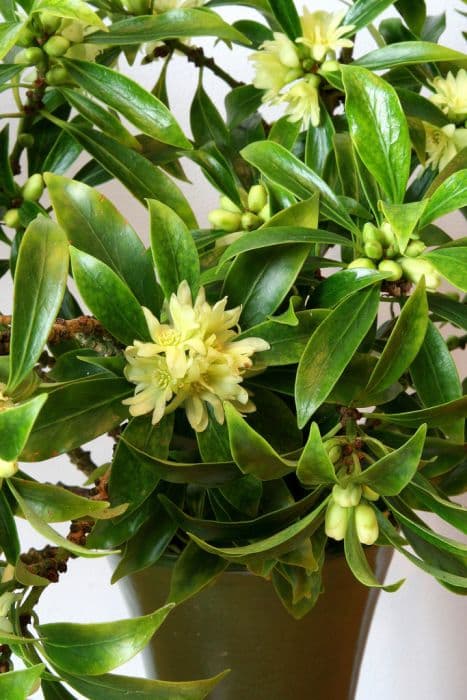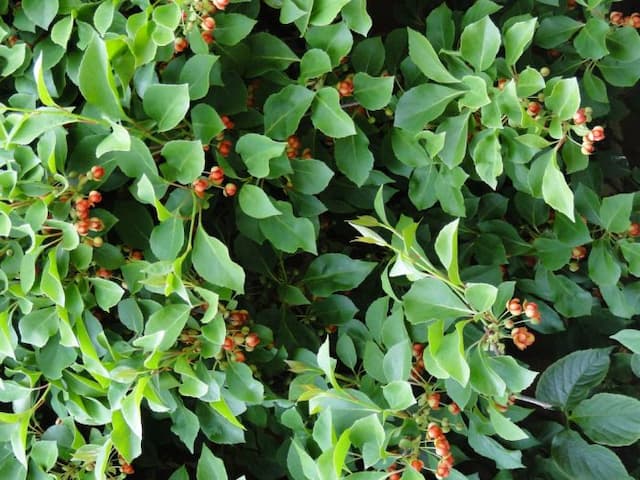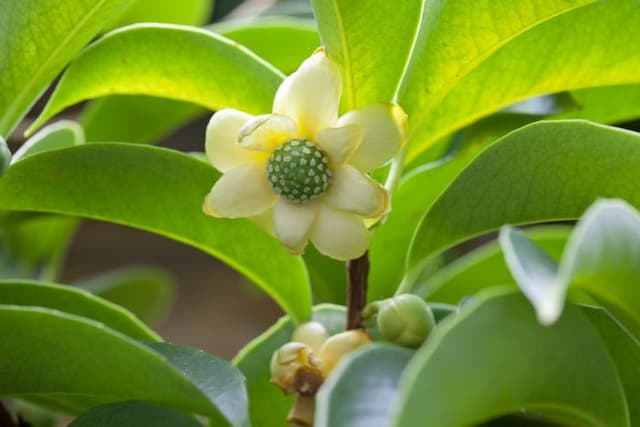Magnolia Vine Schisandra grandiflora

ABOUT
Schisandra grandiflora, often referred to simply as Schisandra, is a striking plant with a lush appearance. The plant boasts a series of green leaves that have a glossy texture, providing a vibrant and hearty backdrop to its more distinctive features. Amidst the foliage, the plant displays an array of flowers which are particularly noteworthy for their size and showy appeal. These flowers are characterized by their radiance, lending a sense of grandeur to the plant's overall presentation. Delving further into the flowers, what catches the eye is their color—a vivid and intense hue that can range from soft pastel shades to deeper tones. Each flower comprises multiple petals that unfurl from the center, often appearing as though they have been crafted with the utmost care. The arrangement of the petals gives the bloom a sense of fullness and complexity, with a rich texture that invites closer inspection. Additionally, following the blooming period, the plant develops fruit that is quite distinct. The fruit typically has a fleshy exterior and may vary in color, contributing to the visual interest of the plant. In maturity, the plant creates a picturesque display, which is both elegant and robust in its natural setting. Schisandra's aesthetic appeal is a blend of its verdant foliage, resplendent flowers, and noticeable fruit, which together form a lush tapestry of plant life. The plant's visual charm is an amalgamation of color, texture, and form, making it a favored selection for garden enthusiasts seeking to enhance their landscape with an ornamental touch.
About this plant
 Names
NamesFamily
Schisandraceae.
Synonyms
Magnolia Vine, Large-flowered Schisandra.
Common names
Kadsura grandiflora.
 Toxicity
ToxicityTo humans
Schisandra grandiflora, commonly known as magnolia vine, is not typically known for being toxic to humans. However, as with any plant, some individuals may experience adverse reactions such as allergic responses upon ingestion or contact. There is limited information on the severe toxicity and specific symptoms of poisoning from this plant in humans because it is not commonly reported as a toxic plant. It is always advisable to exercise caution and avoid ingesting any plant material that is not proven safe for consumption. If ingestion does occur and adverse symptoms appear, medical attention should be sought.
To pets
Information specifically regarding the toxicity of Schisandra grandiflora, or magnolia vine, to pets is not well-documented. Generally, the plant is not known to be highly toxic to pets. However, as with any non-food plant, consumption should be discouraged, and pets should be monitored for any signs of digestive upset or allergic reactions. If a pet does ingest part of a magnolia vine and exhibits symptoms of poisoning such as vomiting, diarrhea, or unusual behavior, it is essential to contact a veterinarian promptly.
 Characteristics
CharacteristicsLife cycle
Perennials
Foliage type
Deciduous
Color of leaves
Green
Flower color
White
Height
6 feet (1.83 meters)
Spread
6 feet (1.83 meters)
Plant type
Climber
Hardiness zones
6
Native area
Himalayas
Benefits
 General Benefits
General Benefits- Stress Resistance: Schisandra grandiflora may improve the body's resilience to stress and enhance mental performance.
- Boosts Stamina: It is believed to increase energy levels and physical performance.
- Improves Liver Function: The plant can have hepatoprotective effects, supporting liver health.
- Antioxidant Properties: Schisandra grandiflora has compounds that may protect cells from free radical damage.
- Adaptogenic Qualities: As an adaptogen, it can help the body adapt to environmental and psychological stresses.
- Skincare: Some compounds in the plant may benefit skin health through their effects on hydration and elasticity.
 Medical Properties
Medical PropertiesThis plant is not used for medical purposes.
 Air-purifying Qualities
Air-purifying QualitiesThis plant is not specifically known for air purifying qualities.
 Other Uses
Other Uses- Ornamental use: Schisandra grandiflora's vine-like growth habit and attractive flowers make it ideal for decorative purposes in gardens and landscapes.
- Aromatherapy: The fruit's essential oils can be used in aromatherapy diffusers to provide a pleasant scent to living spaces.
- Natural dye: Parts of the plant can be used to derive a natural dye for fabrics or crafts.
- Culinary ingredient: In some cultures, the berries may be used as a flavoring agent in recipes or to make teas and infusions.
- Woodworking: The plant's hardy vines can be dried and woven into furniture or decorative objects.
- Religious ceremonies: In certain traditions, the plant may be used in rituals and ceremonies as a symbol of protection or health.
- Horticultural training: Gardeners often use the vines of Schisandra grandiflora to practice pruning and training techniques due to their vigorous growth.
- Beverage fermentation: The berries can sometimes be fermented to make wines or liqueurs with unique flavors.
- Pot-pourri: Dried berries and flowers can be included in pot-pourri mixes for their fragrance and appearance.
- Animal feed: In some regions, the non-toxic parts of the plant could be used as a feed supplement for certain livestock.
Interesting Facts
 Feng Shui
Feng ShuiThe Schisandra grandiflora is not used in Feng Shui practice.
 Zodiac Sign Compitability
Zodiac Sign CompitabilityThe Schisandra grandiflora is not used in astrology practice.
 Plant Symbolism
Plant Symbolism- Balance: Schisandra grandiflora, also known simply as Schisandra, is often associated with balance due to its combination of five distinct flavor profiles: sweet, sour, salty, bitter, and pungent. This represents the harmony of different elements coming together.
- Endurance: As an adaptogen, Schisandra is said to help the body resist stressors, hence it symbolizes endurance and the ability to thrive in challenging environments.
- Vitality: Schisandra is believed to promote vitality and overall well-being, representing the body's intrinsic energy and strength.
- Purity: In certain traditions, Schisandra is thought to cleanse and purify the body, symbolizing the elimination of negative influences and the achievement of a pure state.
- Health: With a long history of use in traditional medicine, Schisandra represents health and the prevention of illnesses, reflecting its reputed benefits for the immune system.
 Water
WaterThe most common common name for Schisandra grandiflora is the Large-Flowered Magnolia Vine. When watering Large-Flowered Magnolia Vine, it is important to maintain consistently moist soil, especially during the growing season. Water the plant deeply once a week, making sure to soak the soil thoroughly until water runs out of the bottom of the pot. Depending on the size of the plant and environmental conditions, this might equal approximately one to two gallons per week. In hotter months, the plant may require more frequent watering to prevent the soil from drying out, while in cooler months, watering frequency should be reduced to prevent waterlogging.
 Light
LightThe Large-Flowered Magnolia Vine thrives best in partial shade to full sun conditions. It is ideal to place the plant in a spot that receives morning sunlight with dappled or indirect light during the heat of the day. Avoiding intense afternoon sun can help to prevent scorching of the leaves.
 Temperature
TemperatureThe Large-Flowered Magnolia Vine prefers a temperate climate with temperatures ranging from 60°F to 85°F. It can tolerate a minimum temperature of about 50°F but should be protected from frost. The plant's ideal growing conditions include warm days and cooler nights within its preferred temperature range.
 Pruning
PruningThe Large-Flowered Magnolia Vine should be pruned to maintain shape and promote healthy growth. Prune any dead or diseased branches as needed throughout the year. The best time for extensive pruning is during late winter or early spring before new growth begins. Depending on the plant's growth, pruning may be necessary once a year or every other year to keep a tidy appearance.
 Cleaning
CleaningAs needed
 Soil
SoilThe ideal soil mix for Schisandra grandiflora, commonly known as Lemonwood, should be well-draining and rich in organic matter. A mix of loam, peat, and perlite or sand at a ratio of 2:1:1 will provide the necessary drainage and nutrient retention. The soil pH for Lemonwood should be slightly acidic to neutral, ranging from about 5.5 to 7.0 for optimal growth.
 Repotting
RepottingLemonwood or Schisandra grandiflora should be repotted every 2-3 years to replenish the soil and accommodate root growth. Younger plants may require more frequent repotting, while mature plants can be repotted less often. Choose a pot only slightly larger than the current one to prevent overwatering.
 Humidity & Misting
Humidity & MistingLemonwood thrives best in moderate to high humidity levels, ideally between 40% to 70%. Consistently high humidity is beneficial for this plant, mimicking its natural environment. Do not allow the air to become too dry, as it may cause stress to the plant.
 Suitable locations
Suitable locationsIndoor
Provide bright, indirect light and maintain high humidity.
Outdoor
Plant in partial shade with shelter from strong winds.
Hardiness zone
7-9 USDA
 Life cycle
Life cycleThe life of Schisandra grandiflora, commonly known as Large-Flowered Magnolia Vine, starts as a seed that germinates in moist, well-drained soil with indirect sunlight. It then develops into a seedling, where it gradually establishes a root system and sprouts its first leaves. As it transitions into the vegetative stage, the plant grows vigorously, producing climbing stems and large, green leaves. Schisandra grandiflora then enters the flowering stage, where it produces fragrant, hermaphroditic flowers, typically pollinated by insects, which subsequently develop into fleshy, berry-like fruits when fertilized. These fruits mature, containing seeds that, once dispersed, can give rise to new plants. Throughout its life, Schisandra grandiflora requires a consistently moist environment and partial to full shade to thrive and cycle through its perennial growth.
 Propogation
PropogationPropogation time
Spring to early summer
Schisandra grandiflora, commonly known as the Magnolia Vine, is most popularly propagated from seed. The best time to sow the seeds is in the spring after a period of cold stratification, which involves simulating winter conditions to break the seed's dormancy. The seeds should be sown in a well-draining soil mix, lightly covered with soil, and then kept moist until germination. Germination can be slow and erratic, often taking several weeks or even months. Once seedlings have developed a few sets of true leaves, they can be transplanted into individual pots or their final location in the garden, providing a support structure for climbing if necessary.



